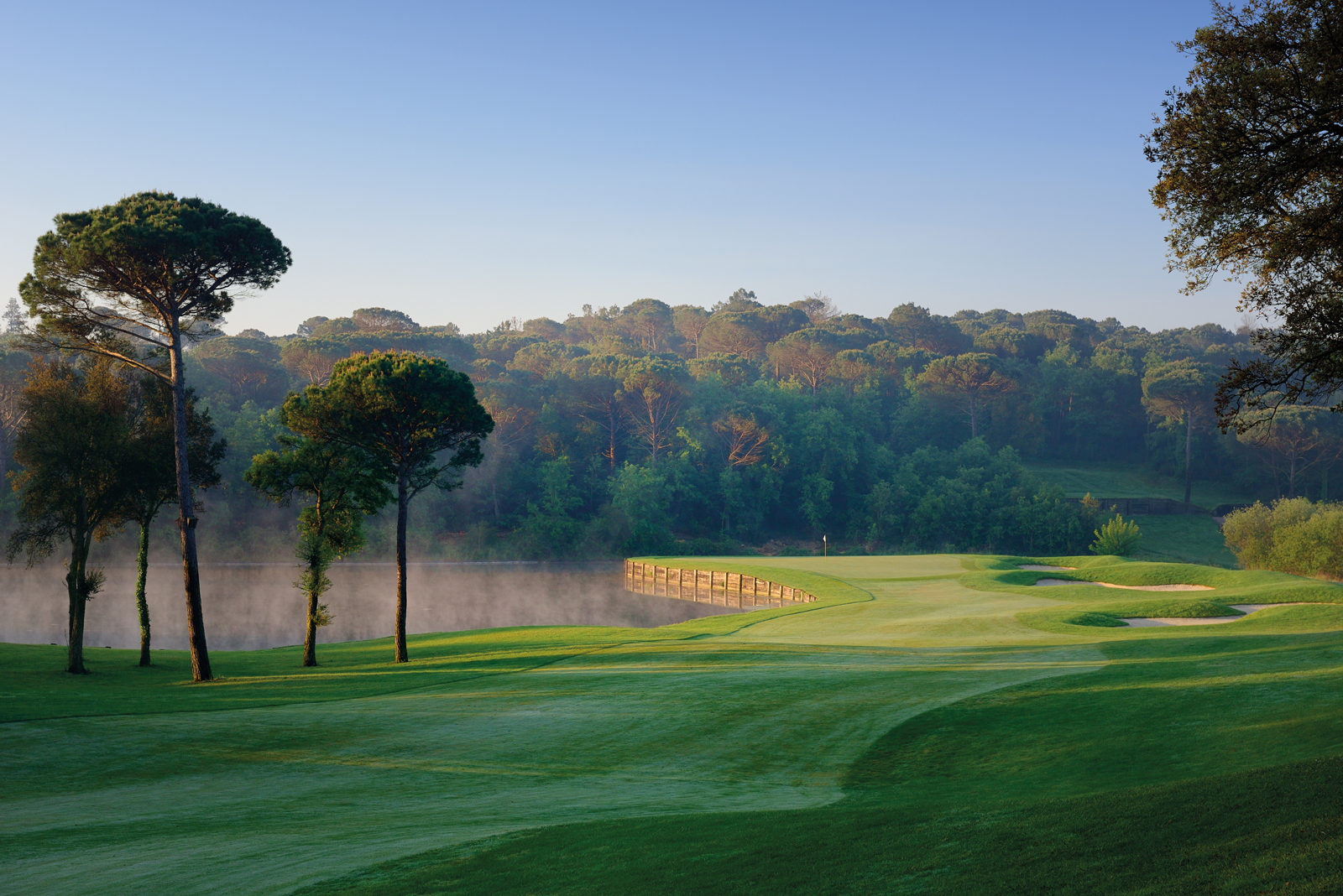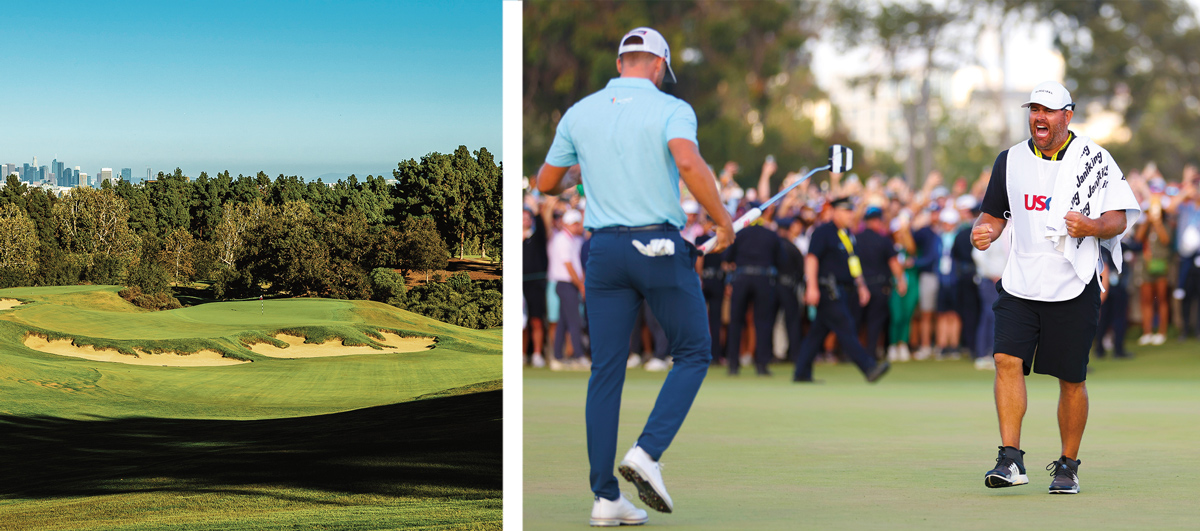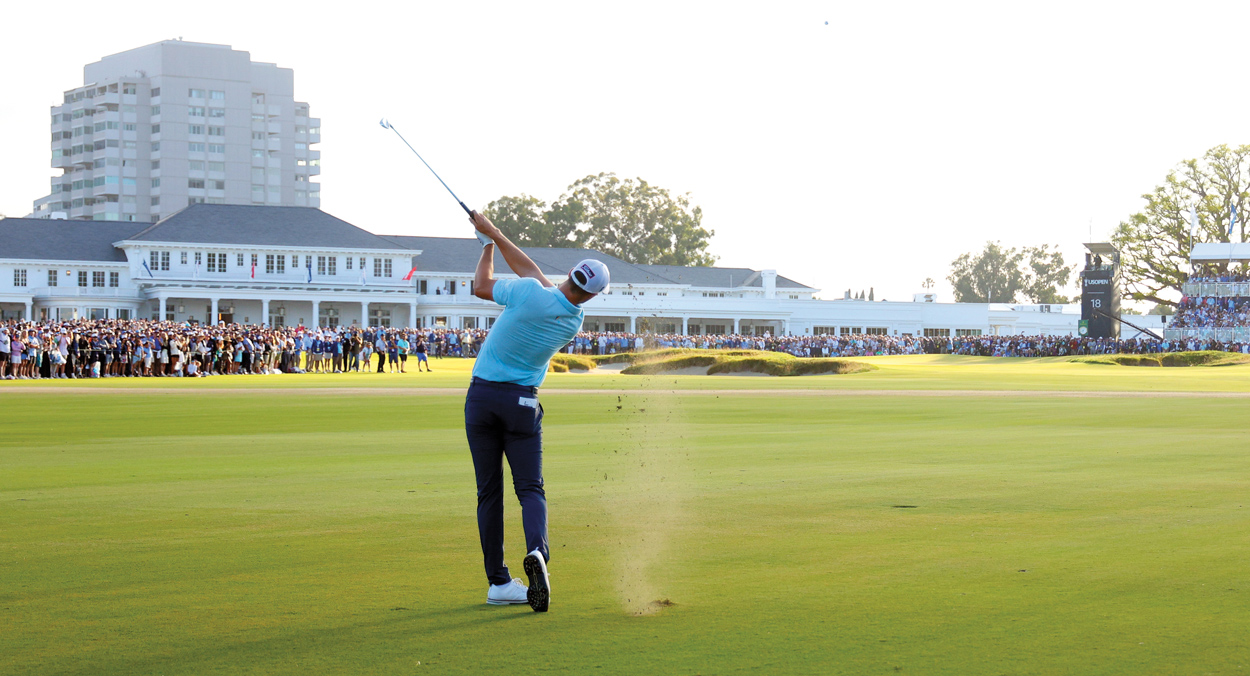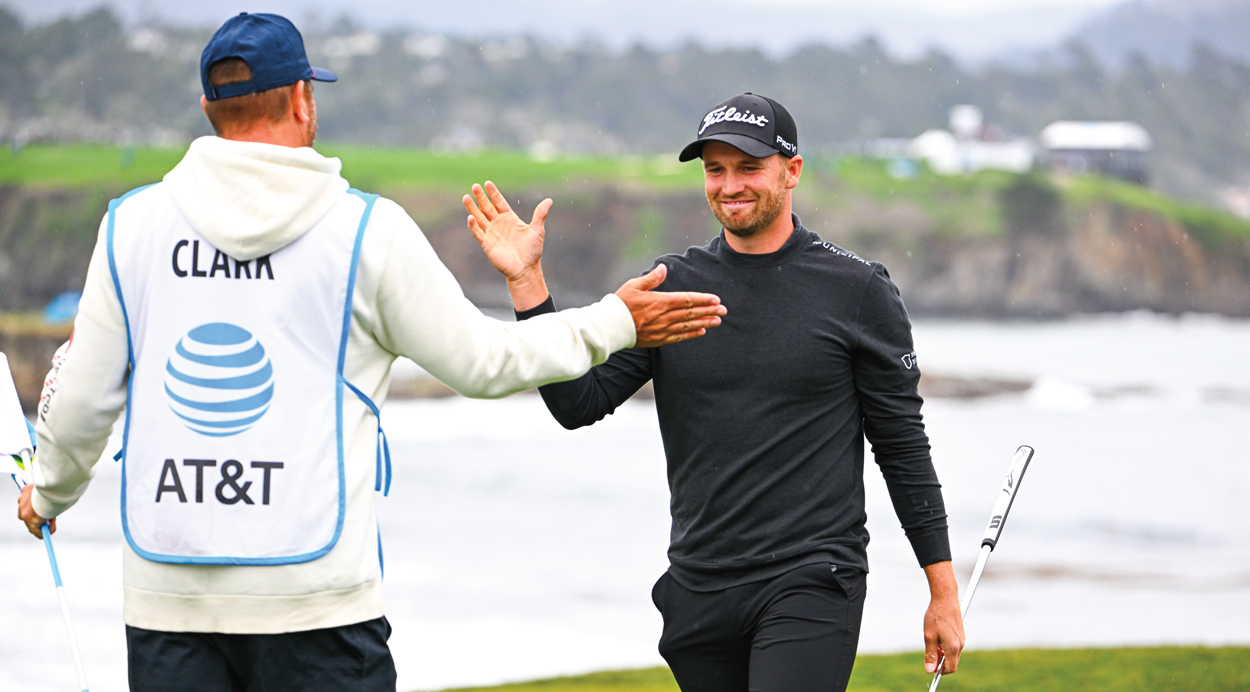
week before Wyndham Clark won the 2023 U.S. Open at Los Angeles Country Club, he visited the exclusive parcel in Beverly Hills to play the course before the crowds and major-championship tensions descended. Clark’s caddie, John Ellis, texted to ask how it went.
“The course is amazing, perfect for us, we’re going to win the U.S. Open,” Clark texted back.
“We don’t need to show up until Thursday,” he joked. “I have the course figured out.”
Lighthearted as it was, Clark’s response proved prescient. “The day after we won, John said, ‘Do you remember texting me that we were going to win?’ I said, ‘I did?’ John showed me the texts, and I was like, ‘Oh my gosh, how crazy is that?’ ”
Not all that crazy, it turns out. Clark, now 30, was not among the popular pre-championship favorites last June, but he had won the Wells Fargo Championship a month before at Quail Hollow—his first PGA Tour victory—and his confidence was sky-high.
“Winning the Wells Fargo gave Wyndham the comfort to go and win the U.S. Open,” says Ellis, who has caddied for Clark since he joined the PGA Tour in 2018. “There is no substitute for winning. It allowed Wyndham to be calmer and to play with more freedom, and not to shy away from big moments.”
The course also made Clark feel at home. “I just felt really good there from the start,” he explains. “The tee shots fit my eye, I love the course design and the topography, and the greens were amazing. I thought everything about it was awesome.”

Despite his high level of comfort at LACC—and opening the championship with a sizzling 64—Clark struggled to close out the U.S. Open. He was in the final pair with California-born Rickie Fowler for the final round, who was also striving for a first major success, while Rory McIlroy, the popular Irishman, was searching for his first major win in nine years, in the group ahead. Many in the crowd treated Clark as if he were just along for the ride, cheering for his more famous rivals and even calling for Clark’s putts to miss.
In the end, however, Fowler slumped to a final-round 75, McIlroy’s putter ran cold down the final stretch, and they were out-lasted by the outsider, who closed with a level-par 70 to edge McIlroy by a shot.
Ellis has played a key role in helping Clark reach the top of the world game, ever since the pair met at the University of Oregon in 2016. At the time, both men needed a restart. Denver-born Clark had transferred from Oklahoma State after his college career had begun to wane, while he struggled to come to terms with the loss of his mother, Lise, who died of breast cancer when he was 19. Ellis joined Oregon as assistant coach to Casey Martin soon afterwards, also looking for a fresh challenge after his own tour career had faltered.

“Having just come off tour, John was playing at a really high level,” recalls Clark (who, incidentally, played high school basketball with 49ers running back Christian McCaffrey, at Valor Christian in Highlands Ranch, Colorado). “John and I would play a lot, and while I would beat the rest of the guys on the team consistently, John would then beat me. I would shoot a 67 or 68, beat the other guys and think that was a great score, but then John would shoot 64 or 65. He would say, ‘I couldn’t make it on tour, so if you can’t beat me, how the heck are you going to make it out there?’
“John challenged me to dig deeper, he pushed me, and playing against him was a great barometer of where my game was. Throughout the fall semester, I hardly beat John, and then midway through the spring semester, I started to consistently beat him. Sure enough, I was winning college tournaments, and I was named Player of the Year, and it was because of the money games I played against John.”
“I had heard about this hotshot kid coming in from Oklahoma who was all-world this and that, but who was looking for a fresh start,” adds Ellis, 44. “Wyndham had the ability to be a superstar, but he didn’t quite know how to handle himself in all situations. There are very few guys, even on the PGA Tour, who can hit the ball 330 yards, and chip and putt like Wyndham does. Physically all the skills were there, but it has taken a while to complete the package.
“The thing about Wyndham is that he was not satisfied with being an okay golfer. He wanted to be great. He worked really hard, and I loved that. He works his tail off to this day. His hunger and desire have not changed at all.”
When Ellis asked Clark not to make the same mistakes that Ellis had made as a professional, the advice resonated.
“I failed on tour because I made excuses, and I blamed others, and I failed to address my attitude,” explains Ellis, “and Wyndham was heading towards that path. I told him to do the opposite. There are so many highs and lows in golf, and you can swing from one to the other really fast, but we try to stay more neutral, day in, day out.”
Adds Clark, “The mental side has always been a challenge. It is still a work in progress, and John and I are constantly working on it. John can get in my face and say, ‘Hey, get your act together, we need to finish this round.’ Sometimes I can get in my own head, and John is really good at calling me out and getting me back on track.”
When their son was 11, Clark’s parents scraped together the money to pay for a membership at the prestigious Cherry Hills Country Club. Regular Kingdom readers will know that Cherry Hills is where this magazine’s founder, Arnold Palmer, enjoyed what is arguably his most famous day, when he won the 1960 U.S. Open, despite beginning the final round seven shots off the lead.

“I give Cherry Hills a lot of credit for helping me reach tour-level golf,” says Clark, who is paying thanks to the club by giving it a replica of his U.S. Open trophy. “It is a world-class golf course, and there were a bunch of really good junior golfers there. Until I was 11, I had played at a public range, so to move to a country club where I could hit unlimited golf balls, that was my candy store. I no longer had to put money in a ball machine. I would say, ‘Dad, we have free golf balls!’ He would sigh and say, ‘Yeah, isn’t that great?’ ”
Clark grew up not only hitting as many golf balls as he could, but also appreciating the legend of Palmer and how he strode up to the first tee of that fateful final round in 1960—back then a par-4 playing 318 yards—and smashed his tee shot onto the green. It was a courageous shot, typical of Palmer, and it set up his victory charge.
“The tips are now further back, but we would always play the first hole from the Palmer tee, because it was fun to start a round by trying to drive the green,” says Clark. “I think I was 15 the first time I drove the green. It might have landed short and bounced to the fringe of the green but I counted that as driving the green. It was always a good feeling to birdie the first at Cherry Hills. Now when I go back, from that Palmer tee I have to hit a soft, cut 3-wood to reach the green. It is amazing how much farther we hit the ball with modern technology. The fact that Palmer drove the green in 1960 is pretty remarkable.
“Some say it was the greatest U.S. Open ever,” adds Clark, “given that Palmer, Hogan and Nicklaus were all in contention.” Billy Casper wasn’t far off either, and Gary Player and Sam Snead were in the conversation until the final round.
“I really appreciate that I grew up at a place like Cherry Hills, and I have a lot of respect for Arnold Palmer and what he accomplished. It is surreal that I spent my childhood walking past that display in the clubhouse about 1960, hoping that I could win the U.S. Open one day, and that I eventually did it.”
Clark won’t be considered an outsider when he makes his Masters debut in April. He shot a course-record 60, 12 under par, in the third round of the AT&T Pebble Beach Pro-Am in February, to set up his third win in 10 months. And that 60 looked like it might be a 58 for a while. His confidence is high, and as he has a couple games scheduled at Augusta National ahead of Masters week, caddie Ellis is likely to be checking his texts regularly.
Follow Us On


| Cookie | Duration | Description |
|---|---|---|
| cookielawinfo-checkbox-analytics | 11 months | This cookie is set by GDPR Cookie Consent plugin. The cookie is used to store the user consent for the cookies in the category "Analytics". |
| cookielawinfo-checkbox-functional | 11 months | The cookie is set by GDPR cookie consent to record the user consent for the cookies in the category "Functional". |
| cookielawinfo-checkbox-necessary | 11 months | This cookie is set by GDPR Cookie Consent plugin. The cookies is used to store the user consent for the cookies in the category "Necessary". |
| cookielawinfo-checkbox-others | 11 months | This cookie is set by GDPR Cookie Consent plugin. The cookie is used to store the user consent for the cookies in the category "Other. |
| cookielawinfo-checkbox-performance | 11 months | This cookie is set by GDPR Cookie Consent plugin. The cookie is used to store the user consent for the cookies in the category "Performance". |
| viewed_cookie_policy | 11 months | The cookie is set by the GDPR Cookie Consent plugin and is used to store whether or not user has consented to the use of cookies. It does not store any personal data. |